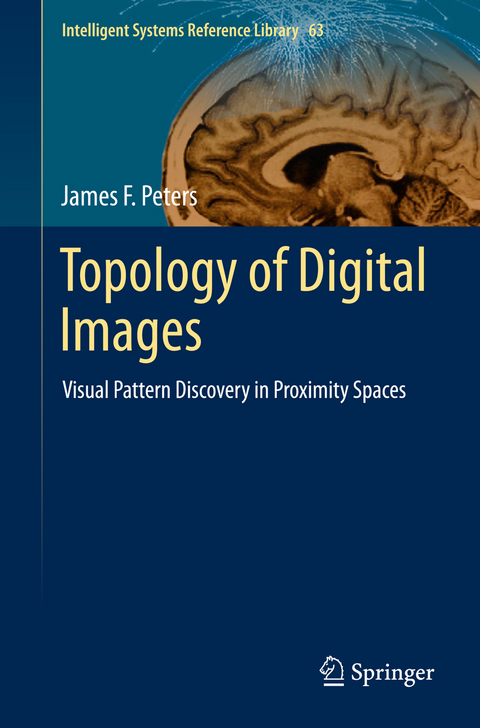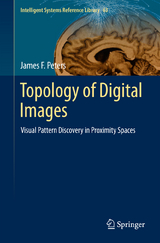Topology of Digital Images
Visual Pattern Discovery in Proximity Spaces
Seiten
2014
|
2014
Springer Berlin (Verlag)
978-3-642-53844-5 (ISBN)
Springer Berlin (Verlag)
978-3-642-53844-5 (ISBN)
This book introduces the basics of digital images from a computer vision perspective, as well as the basics of proximity spaces, considering not only a traditional view of spatial proximity relations but also the more recent descriptive proximity relations.
This book carries forward recent work on visual patterns and structures in digital images and introduces a near set-based a topology of digital images. Visual patterns arise naturally in digital images viewed as sets of non-abstract points endowed with some form of proximity (nearness) relation. Proximity relations make it possible to construct uniform topologies on the sets of points that constitute a digital image. In keeping with an interest in gaining an understanding of digital images themselves as a rich source of patterns, this book introduces the basics of digital images from a computer vision perspective. In parallel with a computer vision perspective on digital images, this book also introduces the basics of proximity spaces. Not only the traditional view of spatial proximity relations but also the more recent descriptive proximity relations are considered. The beauty of the descriptive proximity approach is that it is possible to discover visual set patterns among sets that are non-overlapping and non-adjacent spatially. By combining the spatial proximity and descriptive proximity approaches, the search for salient visual patterns in digital images is enriched, deepened and broadened. A generous provision of Matlab and Mathematica scripts are used in this book to lay bare the fabric and essential features of digital images for those who are interested in finding visual patterns in images. The combination of computer vision techniques and topological methods lead to a deep understanding of images.
This book carries forward recent work on visual patterns and structures in digital images and introduces a near set-based a topology of digital images. Visual patterns arise naturally in digital images viewed as sets of non-abstract points endowed with some form of proximity (nearness) relation. Proximity relations make it possible to construct uniform topologies on the sets of points that constitute a digital image. In keeping with an interest in gaining an understanding of digital images themselves as a rich source of patterns, this book introduces the basics of digital images from a computer vision perspective. In parallel with a computer vision perspective on digital images, this book also introduces the basics of proximity spaces. Not only the traditional view of spatial proximity relations but also the more recent descriptive proximity relations are considered. The beauty of the descriptive proximity approach is that it is possible to discover visual set patterns among sets that are non-overlapping and non-adjacent spatially. By combining the spatial proximity and descriptive proximity approaches, the search for salient visual patterns in digital images is enriched, deepened and broadened. A generous provision of Matlab and Mathematica scripts are used in this book to lay bare the fabric and essential features of digital images for those who are interested in finding visual patterns in images. The combination of computer vision techniques and topological methods lead to a deep understanding of images.
Preface.-
1 Topology of Digital Images: Basic Ingredients.-
2 Structures Arising from Sets of Pixels.-
3 Visualisations and Covers.-
4 Linear Filtering and Visual Patterns in Images.-
5 Edges, Lines, Ridges, and Nearness Structures.-
6 Corners and Symmetric Proximity.-
7 Separation of Image Regions and Set Patterns.-
8 Descriptive Raster Spaces.-
9 Component Analysis and Uniform Spaces.-
10 Shapes and Shape Set Patterns.-
11 Texture and Texture Set Patterns.-
12 Pattern-Based Picture Classification.-
13 Appendix: Matlab and Mathematica Scripts.-
14 Notes and Further Readings.
From the reviews:
"This book presents the recent research results of visual patterns in proximity spaces in a very easy to follow way. ... a research exposition for mathematicians, computer scientists, engineers and for all who want to familiarize with the recent research in this field. It can be also treated as the textbook for students and for all who want to deeply understand images through their topology. It can be used for a self studying and as a course book as well." (Agnieszka Lisowska, zbMATH, Vol. 1295, 2014)| Erscheint lt. Verlag | 14.2.2014 |
|---|---|
| Reihe/Serie | Intelligent Systems Reference Library |
| Zusatzinfo | XVI, 411 p. 250 illus., 158 illus. in color. |
| Verlagsort | Berlin |
| Sprache | englisch |
| Maße | 155 x 235 mm |
| Gewicht | 801 g |
| Themenwelt | Informatik ► Grafik / Design ► Digitale Bildverarbeitung |
| Informatik ► Theorie / Studium ► Künstliche Intelligenz / Robotik | |
| Technik | |
| Schlagworte | Digital Image Analysis • Digital Image Processing • Image Structures • Neighbourhood • SET • Symmetric Proximity • Topology |
| ISBN-10 | 3-642-53844-4 / 3642538444 |
| ISBN-13 | 978-3-642-53844-5 / 9783642538445 |
| Zustand | Neuware |
| Haben Sie eine Frage zum Produkt? |
Mehr entdecken
aus dem Bereich
aus dem Bereich
Modelle für 3D-Druck und CNC entwerfen
Buch | Softcover (2022)
dpunkt (Verlag)
34,90 €
alles zum Drucken, Scannen, Modellieren
Buch | Softcover (2024)
Markt + Technik Verlag
24,95 €




